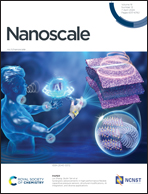Copper single-site engineering in MOF-808 membranes for improved water treatment†
Abstract
MOF-808, a metal–organic framework containing Zr6O8 clusters, can serve as a secure anchoring point for stabilizing copper single-sites with redox activity, thus making it a promising candidate for catalytic applications. In this study, we target the incorporation of Cu-MOF-808 into a mixed-matrix membrane for the degradation of tyrosol, an emerging endocrine-disrupting compound commonly found in water sources, through Fenton reactions, developing innovative technologies for water treatment. We successfully demonstrate the effectiveness of this approach by preparing catalytic membranes with minimal metal leaching, which is one of the primary challenges in developing copper-based Fenton heterogeneous catalysts. Furthermore, we utilized advanced synchrotron characterization techniques, combining X-ray absorption spectroscopy and pair distribution function analysis of X-ray total scattering, to provide evidence of the atomic structure of the catalytic copper sites within the membranes. Additionally, we observed the presence of weak interactions between the MOF-808 and the organic polymer, potentially explaining their enhanced stability.



 Please wait while we load your content...
Please wait while we load your content...